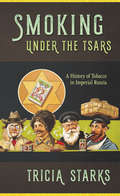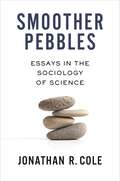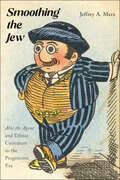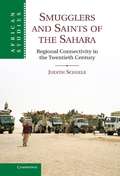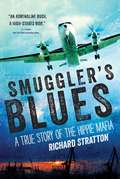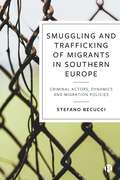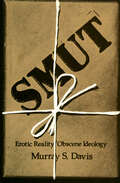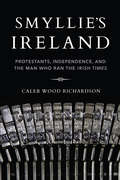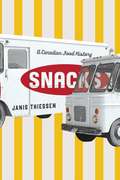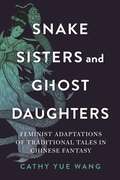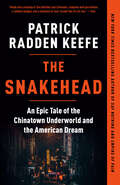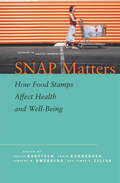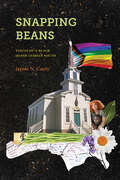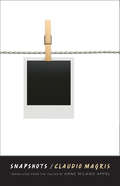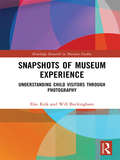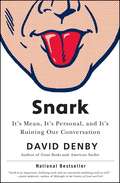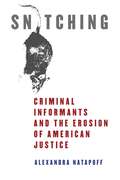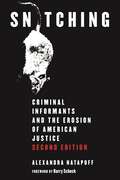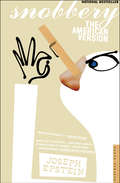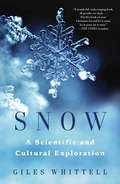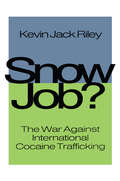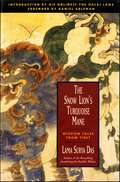- Table View
- List View
Smoking under the Tsars: A History of Tobacco in Imperial Russia
by Tricia StarksApproaching tobacco from the perspective of users, producers, and objectors, Smoking under the Tsars provides an unparalleled view of Russia’s early adoption of smoking. Tricia Starks introduces us to the addictive, nicotine-soaked Russian version of the cigarette—the papirosa—and the sensory, medical, social, cultural, and gendered consequences of this unique style of tobacco use.Starting with the papirosa’s introduction in the nineteenth century and its foundation as a cultural and imperial construct, Starks situates the cigarette’s emergence as a mass-use product of revolutionary potential. She discusses the papirosa as a moral and medical problem, tracks the ways in which it was marketed as a liberating object, and concludes that it has become a point of increasing conflict for users, reformers, and purveyors.The heavily illustrated Smoking under the Tsars taps into bountiful material in newspapers, industry publications, etiquette manuals, propaganda posters, popular literature, memoirs, cartoons, poetry, and advertising. Starks frames her history within the latest scholarship in imperial and early Soviet history and public health, anthropology and addiction studies. The result is an ambitious social and cultural exploration of the interaction of institutions, ideas, practice, policy, consumption, identity, and the body. Starks has reconstructed how Russian smokers experienced, understood, and presented their habit in all its biological, psychological, social, and sensory inflections, providing the reader with incredible images and a unique application of anthropology and sensory analysis to the experience of tobacco dependency.
Smoother Pebbles: Essays in the Sociology of Science
by Jonathan R. ColeUntil the middle of the twentieth century, few thought of science as a social system, instead seeing scientific discovery as the work of individual geniuses. Columbia University’s Department of Sociology played a pivotal role in advancing the social study of science. Researchers of the “Columbia Program” analyzed how science works as a social institution, exploring its norms, values, and structure.Smoother Pebbles presents a collection of essays authored or coauthored by Jonathan R. Cole, a leading Columbia Program figure, that trace the development and institutionalization of the sociology of science. Spanning from the 1960s to the 2020s and including both empirical and theoretical studies of science, the book is at once wide-ranging and united by core questions. Are scientists rewarded for the merits of their work or for other reasons? How does the system of social stratification in science operate? Has the funding of scientists been the result of an “old boys’ network”? How fair is the peer review process? In what ways does science fall short of its universalistic ideals? What factors have constrained opportunities for women in science? How has science fared amid attacks on academic freedom and free inquiry at universities? Cole’s introduction contextualizes both individual essays and the major concerns of the Columbia Program. Smoother Pebbles is essential reading for those interested in the growth and crucial questions of the sociology and social studies of science.
Smoothing the Jew: "Abie the Agent" and Ethnic Caricature in the Progressive Era
by Jeffrey A. MarxThe turn of the nineteenth century in the United States saw the substantial influx of immigrants and a corresponding increase in anti-immigration and nativist tendencies among longer-settled Americans. Jewish immigrants were often the object of such animosity, being at once the object of admiration and anxiety for their perceived economic and social successes. One result was their frequent depiction in derogatory caricatures on the stage and in print. Smoothing the Jew investigates how Jewish artists of the time attempted to “smooth over” these demeaning portrayals by focusing on the first Jewish comic strip published in English, Harry Hershfield’s Abie the Agent. Jeffrey Marx demonstrates how Hershfield created a Jewish protagonist who in part reassured nativists of the Jews’ ability to assimilate into American society while also encouraging immigrants and their children that, over time, they would be able to adopt American customs without losing their distinctly Jewish identity.
Smugglers and Saints of the Sahara
by Judith ScheeleSmugglers and Saints of the Sahara describes life on and around the contemporary border between Algeria and Mali, exploring current developments in a broad historical and socioeconomic context. Basing her findings on long-term fieldwork with trading families, truckers, smugglers and scholars, Judith Scheele investigates the history of contemporary patterns of mobility from the late nineteenth century to the present. Through a careful analysis of family ties and local economic records, this book shows how long-standing mobility and interdependence have shaped not only local economies, but also notions of social hierarchy, morality and political legitimacy, creating patterns that endure today and that need to be taken into account in any empirically-grounded study of the region.
Smuggler's Blues: A True Story of the Hippie Mafia (Cannabis Americana: Remembrance Of The W Ser. #1)
by Richard StrattonGoodfellas meets Savages meets Catch Me If You Can in this true tale of high-stakes smuggling from pot’s outlaw years. Richard Stratton was the unlikeliest of kingpins. A clean-cut Wellesley boy who entered outlaw culture on a trip to Mexico, he saw his search for a joint morph into a thrill-filled dope run smuggling two kilos across the border in his car door. He became a member of the Hippie Mafia, traveling the world to keep America high, living the underground life while embracing the hippie credo, rejecting hard drugs in favor of marijuana and hashish. With cameos by Whitey Bulger and Norman Mailer, Smuggler’s Blues tells Stratton’s adventure while centering on his last years as he travels from New York to Lebanon’s Bekaa Valley to source and smuggle high-grade hash in the midst of civil war, from the Caribbean to the backwoods of Maine, and from the Chelsea Hotel to the Plaza as his fortunes rise and fall. All the while he is being pursued by his nemesis, a philosophical DEA agent who respects him for his good business practices. A true-crime story that reads like fiction, Smuggler’s Blues is a psychedelic road trip through international drug smuggling, the hippie underground, and the war on weed. As Big Marijuana emerges, it brings to vivid life an important chapter in pot’s cultural history.
Smuggling and Trafficking of Migrants in Southern Europe: Criminal Actors, Dynamics and Migration Policies
by Stefano BecucciThis book provides a contemporary overview of migrant smuggling and trafficking in Southern Europe, focusing on Spain, Italy and Greece. It considers how criminal players increase such activity and investigates institutional and structural constraints to legal migration in Southern Europe. Migrant workers satisfy the need for a cheap workforce to sustain Southern Europe’s economy, and laws to counter irregular migration alter smuggling routes and expose migrants to forms of exploitation upon reaching their destination. Revealing institutional, economic and criminal factors, the book explains the persistence of migrant smuggling and trafficking.
Smut: Erotic Reality/Obscene Ideology
by Murray S. DavisThis unique study of sexuality and society offers a provocative reframing of the subject—including what the author calls a periodic table of perversions. In Smut, Murray S. Davis investigates sex in a way that differs from nearly all previous books on the subject. Discarding the simplistic theory of sex as a natural instinct, he sets out to develop new explanations for its universal appeal. Drawing on a wide variety of literary forms, including the work of novelists, poets, and even comedians—and exploring everything from theology to pornography—Davis recaptures sex for the social sciences. First, Davis examines the difference between sexual arousal and ordinary experience, arguing that arousal alters a person's experience of the world. Positing an erotic reality distinct from everyday life, he demonstrates how different perceptions of time, space, human bodies, and other social types occur in each realm. Davis then asks why some people find this alternation between realities dirty, and offers a periodic table of perversions that summarizes the social elements out of which those who find sex dirty construct their world. Finally, Davis considers other conceptual grids affected by the alternation between everyday and erotic realities: the pornographic, which portrays individual, social relations, and social organizations being disrupted by sex; and the naturalistic, which conceives of them in a way that cannot be disrupted by sex. Throughout history these ideologies have battled for control over Western society, and, in his conclusion, Davis offers a prognosis for the future of sex based on these historical ideological cycles.
Smyllie's Ireland: Protestants, Independence, and the Man Who Ran the Irish Times (Irish Culture, Memory, Place Ser.)
by Caleb Wood Richardson“A thoughtful, superbly researched and elegantly written study of one the most important pioneering Irish newspaper editors of the past 150 years.” —Journal of British StudiesAs Irish republicans sought to rid the country of British rule and influence in the early twentieth century, a clear delineation was made between what was “authentically” Irish and what was considered to be English influence. As a member of the Anglo-Irish elite who inhabited a precarious identity somewhere in between, Irish Times editor R. M. Smyllie found himself having to navigate the painful experience of being made to feel an outsider in his own homeland. In this engaging consideration of a bombastic, outspoken, and conflicted man, Caleb Wood Richardson offers a way of seeing Smyllie as representative of the larger Anglo-Irish experience. Richardson explores Smyllie’s experience in a German internment camp in World War I, his foreign correspondence work for the Irish Times at the Paris Peace Conference, and his guiding hand as an advocate for culture and intellectualism. Smyllie had a direct influence on the careers of writers such as Patrick Kavanagh and Louis MacNeice, and his surprising decision to include an Irish-language column in the paper had an enormous impact on the career of novelist Flann O’Brien. Smyllie, like many of his class, felt a strong political connection to England at the same time as he had enduring cultural dedications to Ireland. How Smyllie and his generation navigated the collision of identities and allegiances helped to define what Ireland is today.“Describes the rich history of Irish Protestants who found themselves aliens in their own land.” —Communication Booknotes Quarterly
Smyllie's Ireland: Protestants, Independence, and the Man Who Ran the Irish Times (Irish Culture, Memory, Place)
by Caleb Wood Richardson“A thoughtful, superbly researched and elegantly written study of one the most important pioneering Irish newspaper editors of the past 150 years.” —Journal of British StudiesAs Irish republicans sought to rid the country of British rule and influence in the early twentieth century, a clear delineation was made between what was “authentically” Irish and what was considered to be English influence. As a member of the Anglo-Irish elite who inhabited a precarious identity somewhere in between, Irish Times editor R. M. Smyllie found himself having to navigate the painful experience of being made to feel an outsider in his own homeland. In this engaging consideration of a bombastic, outspoken, and conflicted man, Caleb Wood Richardson offers a way of seeing Smyllie as representative of the larger Anglo-Irish experience. Richardson explores Smyllie’s experience in a German internment camp in World War I, his foreign correspondence work for the Irish Times at the Paris Peace Conference, and his guiding hand as an advocate for culture and intellectualism. Smyllie had a direct influence on the careers of writers such as Patrick Kavanagh and Louis MacNeice, and his surprising decision to include an Irish-language column in the paper had an enormous impact on the career of novelist Flann O’Brien. Smyllie, like many of his class, felt a strong political connection to England at the same time as he had enduring cultural dedications to Ireland. How Smyllie and his generation navigated the collision of identities and allegiances helped to define what Ireland is today.“Describes the rich history of Irish Protestants who found themselves aliens in their own land.” —Communication Booknotes Quarterly
Snacks: A Canadian Food History
by Janis Thiessen"Snacks" is a history of Canadian snack foods, of the independent producers and workers who make them, and of the consumers who can’t put them down. Janis Thiessen profiles several iconic Canadian snack food companies, including Old Dutch Potato Chips, Hawkins Cheezies, and chocolate maker Ganong. These companies have developed in distinctive ways, reflecting the unique stories of their founders and their intense connection to specific locations. These stories of salty or sweet confections also reveal a history that is at odds with popular notions of “junk food.” Through extensive oral history and archival research, Thiessen uncovers the roots of our deep loyalties to different snack foods, what it means to be an independent snack food producer, and the often-quirky ways snacks have been created and marketed. Clearly written, extensively illustrated, and lavish with detail about some of Canadians’ favorite snacks, this is a lively and entertaining look at food and labour history.
Snake Sisters and Ghost Daughters: Feminist Adaptations of Traditional Tales in Chinese Fantasy (The Donald Haase Series in Fairy-Tale Studies)
by Cathy Yue WangContemporary Chinese film and literature often draw on time-honored fantastical texts and tales which were founded in the milieu of patriarchy, parental authority, heteronormativity, nationalism, and anthropocentrism. Author Cathy Yue Wang examines the processes by which modern authors and filmmakers reshape these traditional tales to develop new narratives that interrogate the ingrained patriarchal paradigm. Through a rigorous analysis, Wang delineates changes in both content and narrative that allow contemporary interpretations to reimagine the gender politics and contexts of the tales retold. With a broad transmedia approach and a nuanced understanding of intertextuality, this work contributes to the ongoing negotiation in academic and popular discourse between past and present, traditional and contemporary, and text and reality in a globalized and postmodern world. Snake Sisters and Ghost Daughtersoffers an engaging interdisciplinary investigation of issues at the heart of these traditional tales such as gender and status hierarchy, marriage and family life, and in-group/out-group distinction. Beyond the content of these individual stories, Wang ties these narratives together across time using cognitive literary criticism, especially affective narratology, to shed new light on the adaptation of literary and cultural texts and their sociopolitical contexts.
The Snakehead: An Epic Tale of the Chinatown Underworld and the American Dream
by Patrick Radden KeefeIn this thrilling panorama of real-life events, the bestselling author of Empire of Pain investigates a secret world run by a surprising criminal: a charismatic middle-aged grandmother, who from a tiny noodle shop in New York&’s Chinatown managed a multi-million dollar business smuggling people.&“Reads like a mashup of The Godfather and Chinatown, complete with gun battles, a ruthless kingpin and a mountain of cash. Except that it&’s all true.&” —Time Keefe reveals the inner workings of Sister Ping&’s complex empire and recounts the decade-long FBI investigation that eventually brought her down. He follows an often incompetent and sometimes corrupt INS as it pursues desperate immigrants risking everything to come to America, and along the way, he paints a stunning portrait of a generation of illegal immigrants and the intricate underground economy that sustains and exploits them. Grand in scope yet propulsive in narrative force, The Snakehead is both a kaleidoscopic crime story and a brilliant exploration of the ironies of immigration in America.
SNAP Matters
by Craig Gundersen Timothy Smeeding Judith Bartfeld James ZiliakIn 1963, President Kennedy proposed making permanent a small pilot project called the Food Stamp Program (FSP). By 2013, the program's fiftieth year, more than one in seven Americans received benefits at a cost of nearly $80 billion. Renamed the Supplemental Nutrition Assistance Program (SNAP) in 2008, it currently faces sharp political pressure, but the social science research necessary to guide policy is still nascent. In SNAP Matters, Judith Bartfeld, Craig Gundersen, Timothy M. Smeeding, and James P. Ziliak bring together top scholars to begin asking and answering the questions that matter. For example, what are the antipoverty effects of SNAP? Does SNAP cause obesity? Or does it improve nutrition and health more broadly? To what extent does SNAP work in tandem with other programs, such as school breakfast and lunch? Overall, the volume concludes that SNAP is highly responsive to macroeconomic pressures and is one of the most effective antipoverty programs in the safety net, but the volume also encourages policymakers, students, and researchers to continue examining this major pillar of social assistance in America.
Snapping Beans: Voices of a Black Queer Lesbian South (SUNY series in Black Women's Wellness)
by Jayme N. CantySnapping Beans offers a collective narrative of Southern queer lesbian women and gender-nonconforming persons. Throughout the text, the American South acts as both a region and a main character, one that can shame and condemn but also serve as a site of reconciliation. Blending autoethnography and oral histories, Jayme N. Canty explores how both geographic location and social spaces, such as the Church, intersect with categories such as race, gender, and sexuality to shape and mark identity. Just as the intergenerational practice of snapping beans provides an opportunity to slow down, Canty enables readers to make space and to hear a new Southern narrative. Filled with both hurt and healing, Snapping Beans chronicles a multivocal journey of coming out, ultimately revealing a South where Black queer lesbians not only live but also, more importantly, thrive.
Snapshots (The Margellos World Republic of Letters)
by Claudio MagrisA collection of brief, but intimate meditations on life and culture ranging from controversial matters to private moments The internationally acclaimed author Claudio Magris offers a collection of brief “snapshots” reflecting on life and culture from 1999 to 2013 through his very personal lens. Some pieces portray private, intimate moments, while others offer views on public, sometimes controversial matters; the tone is sometimes serious, sometimes humorous, sometimes ironic, but always engaging. The panoramic nature of the vignettes is broad in scope, encompassing a variety of subjects rendered in quick, decisive brushstrokes. It is a little like leafing through a photo album of our times and our society while a learned companion seated beside us offers a perceptive running commentary. Magris’s wit—at times pungent, at times self‑deprecating, always keen—is refreshingly affable. A continuing adventure by the author who has reinvented “travel literature.”
Snapshots of Museum Experience: Understanding Child Visitors Through Photography (Routledge Research in Museum Studies)
by Elee Kirk Will BuckinghamChildren are one of the major audiences for museums, but their visits are often seen solely from the point of view of museum learning. In Snapshots of Museum Experience, Will Buckingham draws upon Elee Kirk’s research amongst child visitors to the Oxford University Museum of Natural History, to take a different approach. Using a method of photo-elicitation with four-and five-year-old child visitors to the museum, the book investigates children’s experience of the museum, and in the process undermines many of our assumptions about the interests, needs and demands of child museum visitors. Drawing together the fields of museum studies and childhood studies, the book considers children as active creators of the museum visit. It investigates the way that children navigate and take control of the physical and social spaces of the museum, finding their own idiosyncratic pathways through these spaces. It also explores how elements of the museum ‘light up’, becoming salient to the child visitor. Finally, it investigates how children make sense through intellectually and imaginatively engaging with these elements of the museum visit. Snapshots of Museum Experience gives a unique insight into the sheer diversity of children’s museum experiences and discusses how museums might cater more successfully to the needs of their child visitors. As such, it should be of great interest to academics, researchers and students in the fields of museum studies, visitor studies and childhood studies. It should also be essential reading for museum educators and exhibition designers.
Snark
by David DenbyWhat is snark? You recognize it when you see it-- a tone of teasing, snide, undermining abuse, nasty and knowing, that is spreading like pinkeye through the media and threatening to take over how Americans converse with each other and what they can count on as true. Snark attempts to steal someone's mojo, erase her cool, annihilate her effectiveness. In this sharp and witty polemic, New Yorker critic and bestselling author David Denby takes on the snarkers, naming the nine principles of snark-- the standard techniques its practitioners use to poison their arrows.
Snitching: Criminal Informants and the Erosion of American Justice
by Alexandra Natapoff2010 Honorable Mention, Silver Gavel Award, American Bar AssociationUncovers the powerful and problematic practice of snitching to reveal disturbing truths about how American justice worksAlbert Burrell spent thirteen years on death row for a murder he did not commit. Atlanta police killed 92-year-old Kathryn Johnston during a misguided raid on her home. After being released by Chicago prosecutors, Darryl Moore—drug dealer, hit man, and rapist—returned home to rape an eleven-year-old girl.Such tragedies are consequences of snitching—police and prosecutors offering deals to criminal offenders in exchange for information. Although it is nearly invisible to the public, criminal snitching has invaded the American legal system in risky and sometimes shocking ways. Snitching is the first comprehensive analysis of this powerful and problematic practice, in which informant deals generate unreliable evidence, allow criminals to escape punishment, endanger the innocent, compromise the integrity of police work, and exacerbate tension between police and poor urban residents. Driven by dozens of real-life stories and debacles, the book exposes the social destruction that snitching can cause in high-crime African American neighborhoods, and how using criminal informants renders our entire penal process more secretive and less fair. Natapoff also uncovers the far-reaching legal, political, and cultural significance of snitching: from the war on drugs to hip hop music, from the FBI’s mishandling of its murderous mafia informants to the new surge in white collar and terrorism informing. She explains how existing law functions and proposes new reforms. By delving into the secretive world of criminal informants, Snitching reveals deep and often disturbing truths about the way American justice really works.
Snitching: Criminal Informants and the Erosion of American Justice, Second Edition
by Alexandra NatapoffReveals the secretive, inaccurate, and often violent ways that the American criminal system really worksCurtis Flowers spent twenty-three years on death row for a murder he did not commit. Atlanta police killed 92-year-old Kathryn Johnston during a misguided raid on her home. Rachel Hoffman was murdered at age twenty-three while working for Florida police. Such tragedies are consequences of snitching. Although it is nearly invisible to the public, the massive informant market shapes the American legal system in risky and sometimes shocking ways. Police rely on criminal suspects to obtain warrants, to perform surveillance, and to justify arrests. Prosecutors negotiate with defendants for information and cooperation, offering to drop charges or lighten sentences in exchange. In this book, Alexandra Natapoff provides a comprehensive analysis of this powerful and problematic practice. She shows how informant deals generate unreliable evidence, allow serious criminals to escape punishment, endanger the innocent, and exacerbate distrust between police and poor communities of color. First published over ten years ago, Snitching has become known as the “informant bible,” a leading text for advocates, attorneys, journalists, and scholars. This influential book has helped free the innocent, it has fueled reform at the state and federal level, and it is frequently featured in high-profile media coverage of snitching debacles. This updated edition contains a decade worth of new stories, new data, new legislation and legal developments, much of it generated by the book itself and by Natapoff’s own work. In clear, accessible language, the book exposes the social destruction that snitching can cause in heavily-policed Black neighborhoods, and how using criminal informants renders our entire penal process more secretive and less fair. By delving into the secretive world of criminal informants, Snitching reveals deep and often disturbing truths about the way American justice really works.
Snobbery: The American Version
by Joseph EpsteinObservations on the many ways we manage to look down on others, from &“a writer who can make you laugh out loud on every third page&” (The New York Times Book Review). Snobs are everywhere. At the gym, at work, at school, and sometimes even lurking in your own home. But how did we, as a culture, get this way? With dishy detail, Joseph Epstein skewers all manner of elitism as he examines how snobbery works, where it thrives, and the pitfalls and perils in thinking you&’re better than anyone else. Offering arch observations on the new footholds of snobbery, including food, fashion, high-achieving children, schools, politics, being with-it—whatever &“it&” is—name-dropping, and much more, Epstein explores the shallows and depths of a concept that has become part of our everyday lives . . . for better or worse. &“Smart, witty, perceptive . . . and almost always—in the best sense of the word—entertaining,&” Snobbery provides the ultimate social commentary on arrogance in America (TheWashington Post Book World). It&’s a book you shouldn&’t be caught dead without.
Snobbery: The practices of distinction (21st Century Standpoints)
by David MorganSnobbery is a more serious matter than some may think: the arguments around Brexit and Trump show that accusations of snobbery have become part of political discourse and public sentiment, building social divisions and reflecting deeper issues of class inequality. Social class is not simply about wealth, health and life-chances but also about everyday social experience, such as being included or excluded. As social inequality grows, snobbery is becoming ever more pertinent. This book takes a fresh and engaging look at this key issue, drawing on literature, popular culture and autobiography as well as sociology and history. David Morgan explores the complex history and different varieties of snobbery as well as its all-pervasive character to reveal why, despite claims about the openness of our society, it is still a matter of public concern.
Snow: A Scientific and Cultural Exploration
by Giles WhittellBrimming with interesting facts and surprising anecdotes, this scientific and cultural history opens our eyes to the wonders of one of nature&’s most delicate, delightful, and deadly phenomena: SNOW! Perfect for fans of The Hidden Life of Trees and Rain.Go on an extraordinary journey across centuries and continents to experience the wonders of snow; from the prehistoric humans that trekked and even skied across it tens of thousands of years ago to the multi-billion-dollar industry behind our moving, making, and playing with snow. Blending accessible writing with fascinating science, Giles Whittell explores how snow dictates where we live, provides us with drinking water, and has influenced countless works of art and more. Whittell also uncovers compelling mysteries of this miraculous substance, such as why avalanches happen, how snow saved a British prime minister&’s life, where the legend of the yeti comes from, and the terrifying truth behind the opening ceremony of the 1960 winter Olympics. Filled with in-depth research and whip-smart prose, Snow is an eye-opening and charming book that illuminates one of the most magnificent wonders of nature.
Snow: The biography
by Giles Whittell**The Financial Times' Travel Book of the Year 2018** How many snowflakes does it take to build a snowman? Where is the snowiest place on Earth? When will the last snowflake fall? Snow has a lot in common with religion. It comes from heaven. It changes everything. It creates an alternative reality and brings on irrational behaviour in humans. But unlike most religions, snow has never had a bible, until now. Giles Whittell, a passionate snow enthusiast, takes the reader on a quest through centuries and continents to reveal the wonders of snow. Along the way he uncovers the mysteries of snow crystal morphology, why avalanches happen, how snow saved a British prime minister’s life, and the terrifying truth about the opening ceremony of the 1960 winter Olympics. The Secret Life of Snow is the next best thing to a white Christmas, an anthropology and travelogue for everyone from ski addicts to the millions of people who have never even seen it.
Snow Job: The War Against International Cocaine Trafficking
by Kevin Jack RileyCocaine has had a long and prominent position in the history of American substance abuse. As far back as the late 1800s cocaine was commonly found hi patent medicines, elixirs, and, astonishingly, in the earliest versions of Coca-Cola. Eventually, the potency of cocaine was recognized and its purveyors came under gradual regulation. Events hi the early 1900s kept cocaine use down until World War II, but the extensive drug use of the 1960s once again sparked a national temperance movement. Created in 1989, the Office of National Drug Control Policy maintains responsibility for coordinating and monitoring the nation's countemarcotics policy. But responsibility for coordination and monitoring is not the same thing as control.In Snow Job? Kevin Jack Riley examines source country control policies—policies intended to control the production and export of cocaine from Latin America—and their limitations. Part I draws together drug use, drug production, and drug control policies hi an analytic framework. It goes on to examine the recent history of U.S. drug control policies, source country control policies, the ways hi which cocaine prices affect cocaine use, how cocaine is made, and the vulnerable points in its production. Part II examines the economic effects that production and controls exert on the sources of cocaine—Bolivia and Peru—and probes the Colombian drug lord connection. Part III prescribes an appropriate path for source country cocaine policies and examines their implications for two other widely smuggled drugs, heroin and marijuana.Riley disagrees with analysts who believe that source country control policies can lead to permanent victory hi the war against cocaine, because of the potentially high costs associated with implementing source country control policies on a large scale. He suggests a better strategy would be one that recognizes the severe limits facing interdiction, eradication, and other source country policies, and instead focuses on directing source country resources where they will be most useful. This necessitates defining a regional strategy that elevates political stability and institution building, and demotes traditional countemarcotics objectives. Snow Job? offers original thinking and practical approaches to a multidimensional world problem and will be of interest to policymakers, political scientists, sociologists, and law enforcement officials.
The Snow Lion's Turquoise Mane: Wisdom Tales from Tibet
by Surya DasTales of enlightenment that stem from the centuries-old oral Tibetan tradition, collected by one of the foremost American Buddhist teachers and scholars.Introduction by His Holiness the Dalai LamaThis remarkable book brings together more than 150 authentic Buddhist teaching tales from the Hidden Kingdom of Tibet—most never before translated into English. These captivating stories, legends and yarns—passed orally from teacher to student—capture the vibrant wisdom of an ancient and still-living oral tradition. Magical, whimsical, witty and ribald, The Snow Lion’s Turquoise Mane unfolds a luminous vision of a universe where basic goodness, harmony, and hope prevail.“This collection of more than 150 stories is the only such large anthology in the field of either Tibetan Buddhism or Himalayan folk and fairy tales, and provides unique reading material for both adults and children.” —Mu Soeng Sunim, Tricycle: The Buddhist Review“These wonderful stories of wandering yogis and yak herders echo with uncommon sense and deep wisdom.” —Rick Fields, author of How the Swans Came to the Lake
